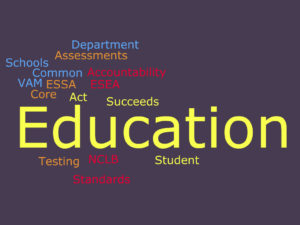 The ball got rolling with President George W. Bush’s 2001 No Child Left Behind Act (NCLB), next made its way to Obama’s Common Core Standards (CCS) online assessments and 2015 Every Student Succeeds Act (ESSA), and then landed on Biden’s lap. He, despite a year of remote instruction and learning losses, put standardized testing front and center this past spring.
The ball got rolling with President George W. Bush’s 2001 No Child Left Behind Act (NCLB), next made its way to Obama’s Common Core Standards (CCS) online assessments and 2015 Every Student Succeeds Act (ESSA), and then landed on Biden’s lap. He, despite a year of remote instruction and learning losses, put standardized testing front and center this past spring.
About that, says Seth Lavin, principal at Chicago’s public elementary Brentano Math and Science Academy and parent, too: “We say we test to teach better… But teaching better is not why we do statewide testing. Results don’t even come back until the year is over. It’s especially hard to see how this year’s numbers will tell us anything, with half our kids still remote and no option to take the test at home.”
Adds Principal Lavin: “We give these tests to make judgments: who’s up and whose down, who’s red and who’s green. We give these tests because we pretend test scores tell us what it means to be a good school, a good teacher, a good student. But they don’t.”
But wait…
Stuart Kahl, an assessment consultant has a different take on testing, backed by 35 years of experience designing, developing, and implementing state assessments and earlier as CEO/founder of Measured Progress, Inc., which operated state testing programs in more than half the states for several decades.
He says:
In recent years, school administrators and teachers have put pressure on state policymakers and testing officials to address the desires of local educators for more immediate information from state tests to inform their day-to-day instruction while still satisfying the federal accountability requirements. Guiding the day-to-day instruction is not something states’ summative-test results can or should be expected to do, despite the ESSA’s unmet requirements for quick, individual student results that are ‘interpretive, descriptive, and diagnostic.’
Standardization in testing means comparability—a quality of state tests that enables local educators and residents in general to get an external perspective on how their local instructional programs are doing. Or does our student performance compare with that of other schools serving similar populations?
State test results should raise questions that need further investigation to answer. Why are underperforming in this subdomain of math? Why is this subgroup in our school underperforming their counterparts in other schools in our state? Are our new approaches in this area working? Finding the answers to such questions informs program-improvement efforts that may not immediately benefit the students test but instead should benefit many more students in the future.
There is strong feeling among educators and noneducators alike that teachers and schools should not be penalized because of the impact of COVID-19 on student learning. I agree. But the need for program-evaluation information is greater than ever right now. How well have we served our students via online instruction, packets sent home, or any other method compared with other schools? What is the extent of learning loss during the pandemic?
State test results should raise questions that need further investigation to answer…
Has Kahl got it right, or are you standing with Principal Lavin?
With thanks and good summer wishes, Carol